Editor’s Note: Today’s post is a guest submission from HHR’s good friend Anonymous in Houston
In 1983, the home entertainment options most American households had were quite limited compared to modern times. Most homes had televisions in 1983, but most people could not do much more than receive local broadcast TV channels on their TVs at that time as cable/satellite TV was still trying to establish itself. There were video games and other home computers in 1983, but the video game industry was facing many issues at the time and the future of video games were unclear in 1983. While one could shop the Sears catalog on video disc as early as 1981, VCRs and video disc players were still very expensive and, thus, not completely common in 1983 even if Michael Pollock of the Colonial House Apartments had no trouble dunking a VCR in a pool.
Thus, aside from basic television, home stereo systems were a common form of home entertainment in 1983. Sure, Sony’s Walkman and other portable cassette players were allowing the public to take their favorite albums with them on the go, but Americans were still buying lots of home stereo receivers, cassette decks, and turntables in the early 1980s. Thus, most retailers were also selling home audio equipment in this era. Popular stores of the time, like Sears, JCPenney, Montgomery Ward, Foley’s, Joske’s, Kmart, Target, Best Products, Fingers, Lowe’s, and even drug and grocery stores were selling stereo equipment! There were also a number of audio and electronic specialty stores in Houston which sold stereo equipment. Many of these were famous for their commercials such as CMC Stereo, the Stereo Warehouse, Federated, Highland, and many others.
By 1983, the audio retail sector was seeing a bit of a slow down. Many people spent a lot of money on audio equipment in the 1970s and early 1980s and, thus, already had a capable sound system. Audio retailers were looking for a technical revolution to bring customers back into their stores and they sure got exactly what they were looking for in 1983! Two large corporations, Sony of Japan and Philips of the Netherlands, started jointly working together in the 1970s to develop a digital audio storage medium using optical discs to try to replace the vinyl record LP discs which had been the industry standard for musical recordings for decades.
Records and tapes had many drawbacks which Sony and Philips hoped to solve with their new digital optical disc, the Compact Disc. Unlike tapes and records, CDs would not incur wear after each playback if the CDs were handled properly. CDs had flat frequency response which meant that all frequencies in the audible spectrum could be played back faithfully. CDs had much less wow & flutter than analog tapes and records. CDs, especially if the music was recorded digitally, did not suffer from tape hiss and they did not have the pops and clicks that were common with dusty records. Also, CDs did not have to be flipped, like a tape or record, to hear the whole program and individual tracks could be selected nearly instantly.
With all of these possible advantages, retailers, record labels, and electronics manufacturers were optimistic that consumers would fall in love with the Compact Disc when CD players arrived in stores across the United States during the summer of 1983. Success was not guaranteed though. As this news report from a Dillard’s department store in Dallas points out, LaserDisc video players had not taken off and, at least initially, CD players were very expensive. There were also few albums available on CD in 1983.
However, as we know, the Compact Disc proved to be a major success. Within mere months of the release of CD players, prices dropped significantly on CD players and the availability of CDs sold at places such as Sound Warehouse increased significantly. This video filmed inside a Pacific Stereo store in Dallas in the summer 1984 discusses how prices on CD players had already fallen significantly from a year prior. This video from the spring of 1985, also filmed at a Pacific Stereo store in Dallas, shows that prices of CD players had already reached mainstream levels in 1985. As this other video from 1985 shows, CDs left household living rooms and became portable via portable players such as the Sony Discman and car CD players. In fact, car CD players were common until just recently. Eventually, the advent of data CD-ROMs for computers and video games, along with user-recordable CDs, made the CD format even more popular. The release of DVD video optical discs for movies in the late 1990s followed a similar trajectory as CDs did for music recordings in the 1980s where the DVD format became ubiquitous for video content after only a handful of years. Of course, CDs can be played in most DVD players.
To get a sense of how retailers were marketing CD players, here is how Sears was marketing their CD player, sold under their own ‘Proformance’ brand, in their 1983 Christmas catalog. At $590, the price had already fallen quite a bit from the summer of 1983. Usually conservative Sears had no problem proudly proclaiming that “Digital audio is awesome” in their marketing! Tandy’s Radio Shack was a bit late in adding Compact Disc players to their stores as it did not show up until their 1985 catalog came out with a model under Tandy’s ‘Realistic’ brand, but here we see Tandy refer to the “amazing” and “ultimate” quality of Compact Disc!
While the days of seeing walls of CD players at places such as Sears and Montgomery Ward’s Electric Avenue are over in modern times and are replaced by racks of used CD and DVD players at places such as Goodwill, there are still some places around town to buy CDs even if most music listeners have switched to streaming Internet audio and most collectors have returned to focusing their attention, for the most part, on records. Half Price Books is the most obvious place to go to find mostly used CDs, but there are some remaining shops for new CDs such as the Classical Music of Spring shop in Old Town Spring which sells new classical music CDs. Classical Music of Spring, which used to be located within the Weslayan Plaza by the Randall’s Flagship and then later 3514 S Shepherd Dr. when they were known as Joel’s Classical Shop, is one of the last classical music CD shops left in the country according to this recent Texas Monthly article about the shop.
As a classical music lover myself, we were fairly early adopters of the CD format. We waited a few years for the prices to drop before we purchased our first CD player from Service Merchandise, a 1980s Teac unit which I still have and which still works. That said, I do have some older CDs, including some released around the time CD players were first sold in the US, in my collection of CDs. For me, personally, it was quite amazing to see those early days of the CD format and all the excitement the CD format brought to a wide variety of retailers. It was always exciting to go to an electronics store or electronics department of a department store/catalog showroom and play around with the latest CD players and cassette decks in the 1980s. I still enjoy buying new CDs today as I enjoy putting a disc on and enjoying high-quality sound reproduction.
Do you have any special memories of shopping for CDs and CD players in the 1980s? If so, or if you have any other comments, please feel free to leave a comment in the comments section below. We love to hear from our readers!

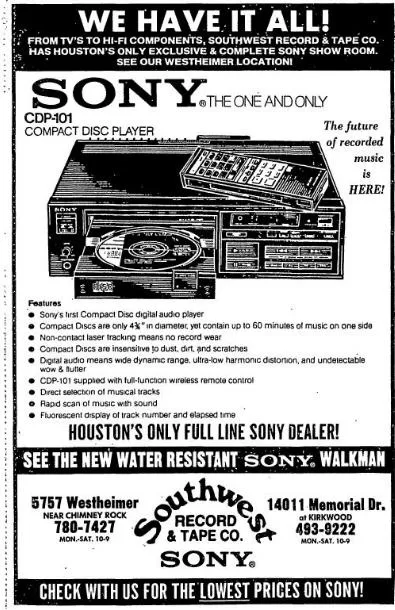

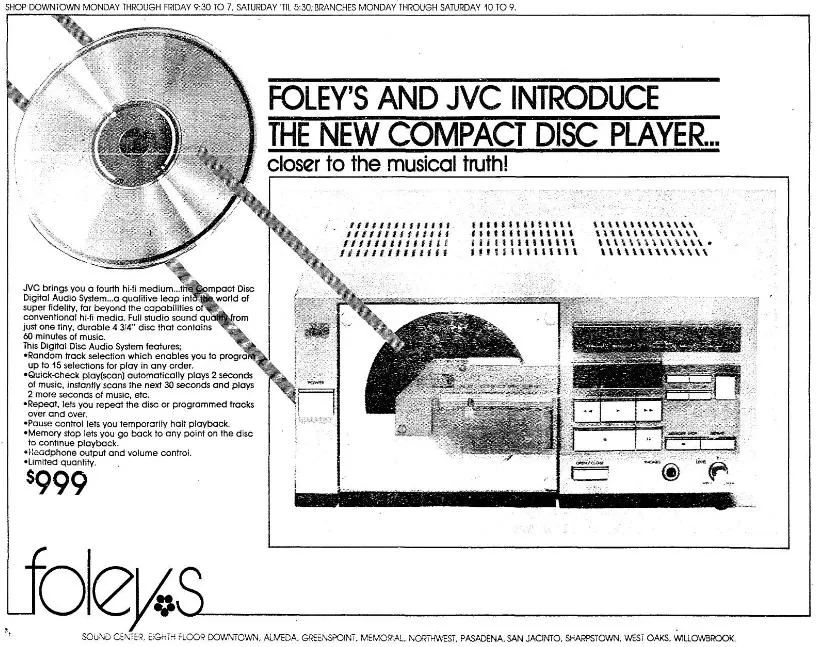
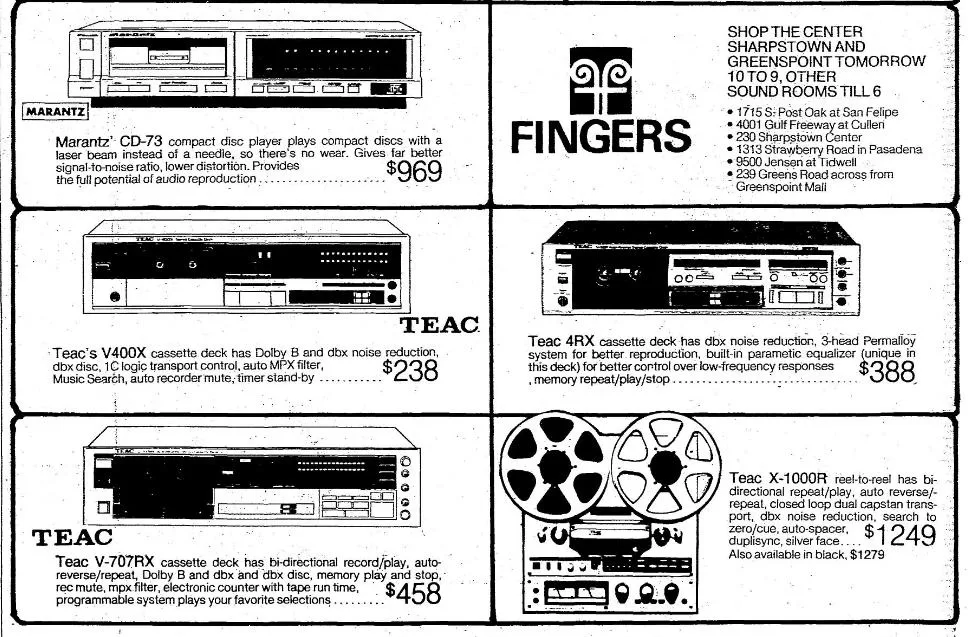
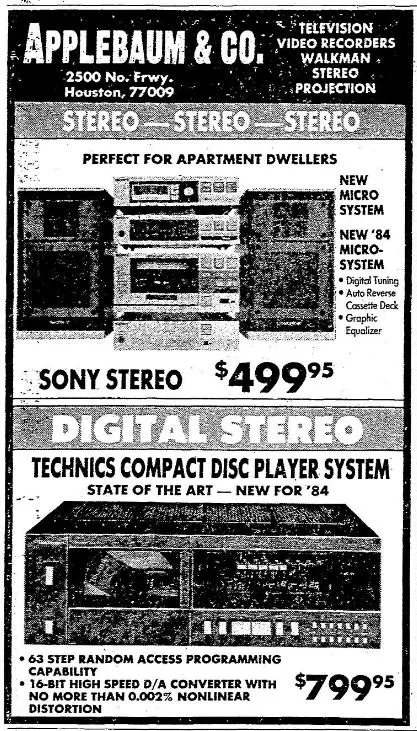
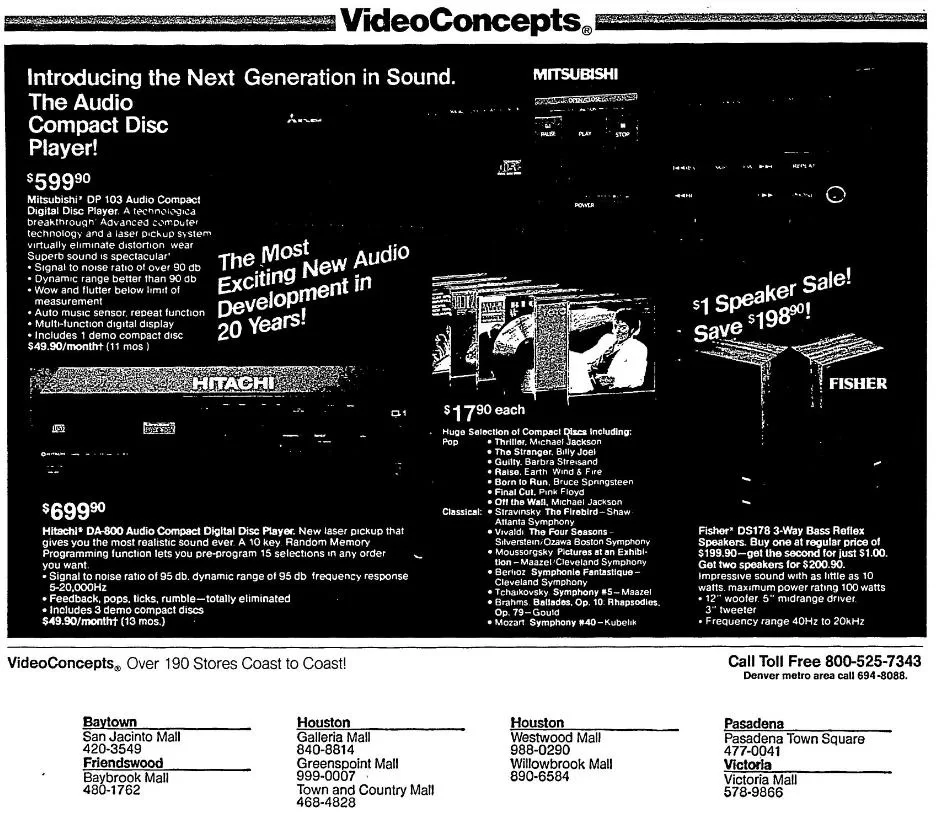
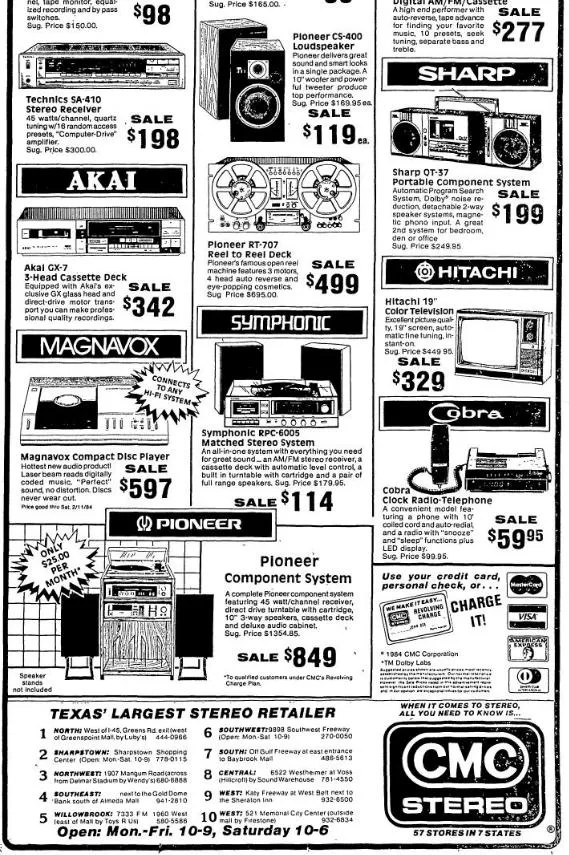
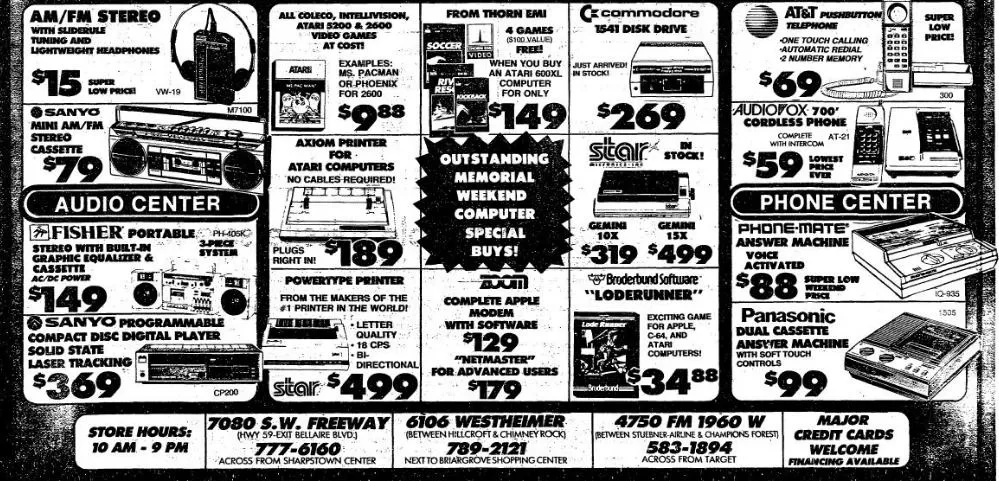
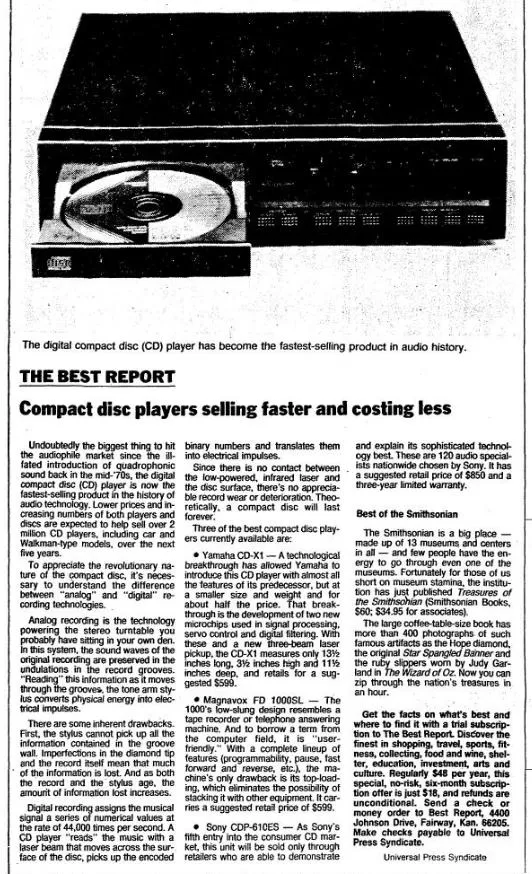
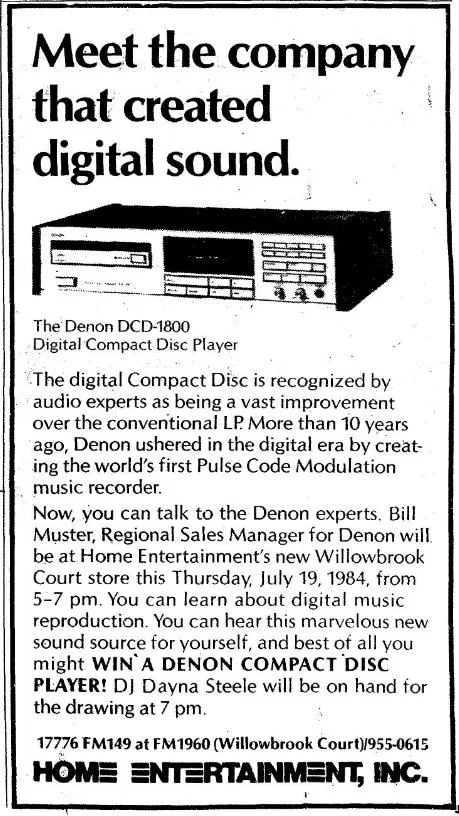
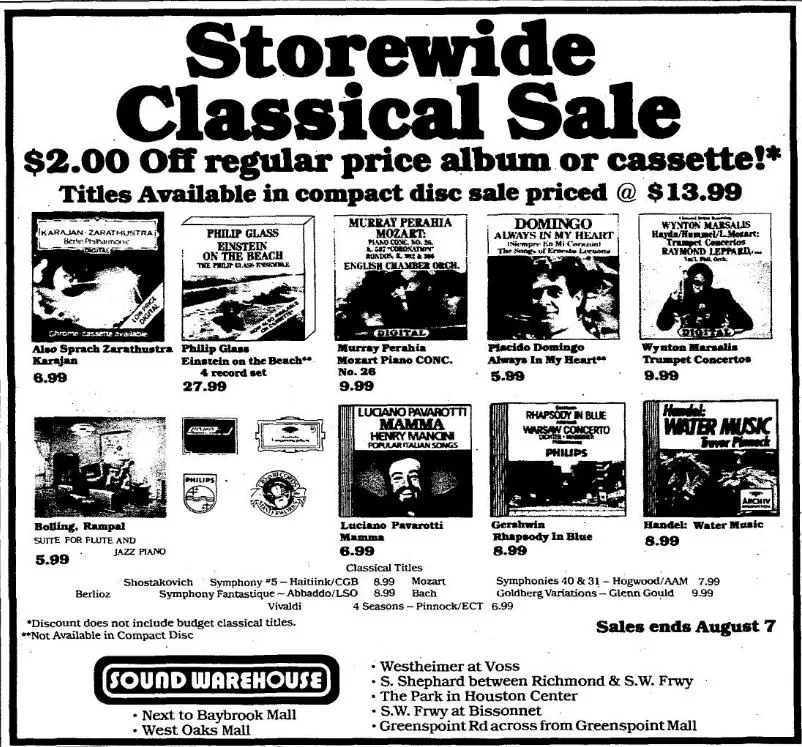

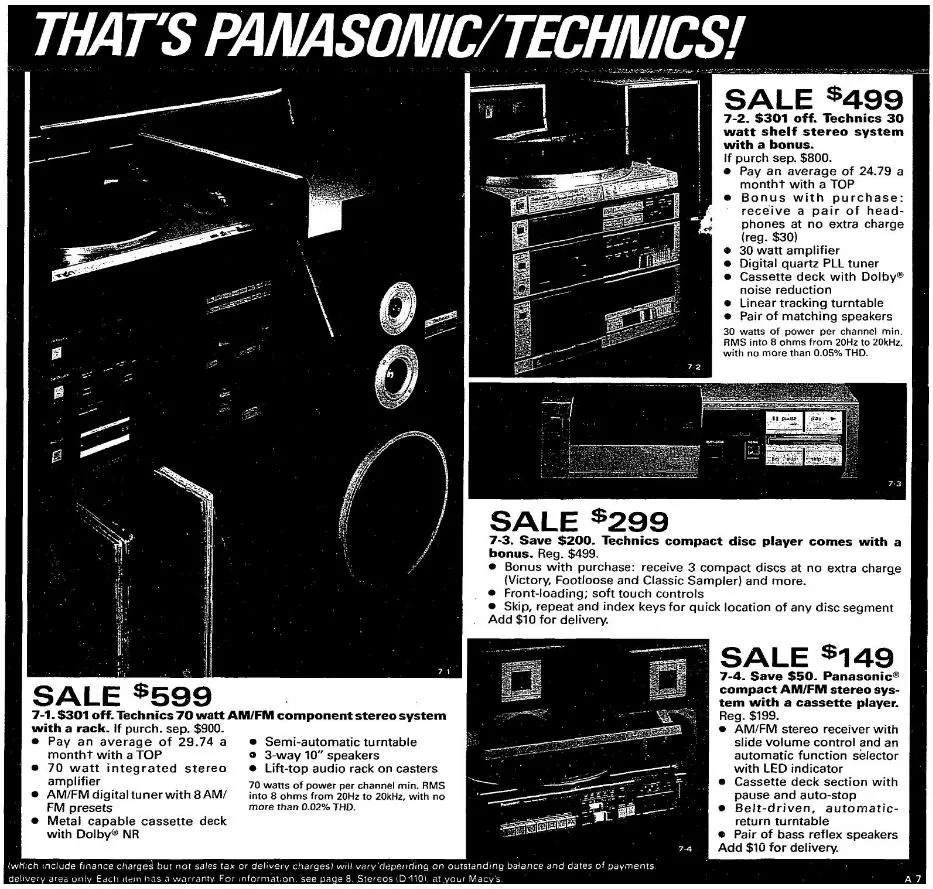
Another interesting piece of history! It’s hard to believe that even Lowe’s carried CD players at one point, but I suppose it wouldn’t be out of the question to find a Bluetooth speaker in a store today.
I have yet to come across this myself, but I’ve heard that the dye in CDs breaks down over time and only has an expected lifetime of a couple of decades. They are certainly much more stable than cassette tapes (I’ve recently played some from the early-1990’s that sound like garbage now), but they say vinyl records have a far superior shelf-life compared to the other two mediums—as long as they don’t warp.
Lowe’s history in Houston is quite strange. They came to Baytown in the late 1970s/early 1980s. Baytown was discussed in last month’s The Year of Kroger post. Anyway, their presence in Baytown must not have been a success because they left after a few years, but then returned to Houston in around the mid-1990s when they were starting to expand aggressively across the country. By the mid-1990s, they were a Home Depot clone, but it seems that Lowe’s had a full electronics department back in the days when they were in Baytown. I never shopped at Lowe’s until the 1990s so I can’t say for sure what it was like, but I suppose this might explain why Lowe’s is, and historically has been, stronger in appliances than Home Depot given their history of taking on the Sears of the world in more than one way.
There are actually two different types of CDs which are common, pressed CDs and CD-Rs. With a pressed CD, like most commercial music releases, the data is more or less stamped into a thin metal layer and those CDs are quite durable as long as they aren’t scratched. Some early 1980s CDs have had problems with the metal layer deteriorating, but pressed CDs are usually very reliable if handled correctly. Pressed CDs have that silver color to them.
CD-Rs, which are the CDs used with computer CD burners, use a dye (which, these days at least, has a greenish silver look) instead of pressed metal. The dye can break down especially if the burned surface sees UV light and/or extreme temperatures/humidity. If sheltered from UV and extreme temperatures, a CD-R should last decades. One which is left on a car dashboard or something like that might last mere days before breaking down.
I’ve been using CD-Rs since the mid-1990s and I’ve only had a handful of discs which have gone bad if they were stored correctly out of the hundreds I’ve burned. Unfortunately, a lot of people use/used CD-Rs for car CD players and I think this is one reason why CD-Rs have a bad reputation. Also, in the early days when computers were slow, it wasn’t unusual for burns to go wrong and waste a disc. Finally, sometimes people burned CDs at maximum speed and this didn’t always yield the best, most reliable results. CD-Rs are a bit finicky I suppose, but if used and stored properly, they are pretty reliable. I actually still burn CDs since I buy tracks of out of print classical music CDs and then make my own CDs at home. Some commercial CDs might be on a CD-R if it is a low volume album, re-print, or something like a concert recording CD like what Retail Retell mentioned.
Cassettes and LPs are also finicky. Like CDs, neither like heat and humidity. If stored correctly, and if a quality cassette was used, cassettes can sound reasonably good even at 50+ years old. I know because I have some cassettes that old. Of course, with cassettes, you also need to know what kind of noise reduction was used and then play the tape back with that noise reduction or else the sound might be distorted. There are other foibles with cassettes. LPs, well, there are a lot that can go wrong with them and some LPs never sounded good even when they were new because of low quality vinyl. That was not uncommon in the 1970s during the oil crisis, but it can be an issue even today with new LPs which cost $35+.
If I had to pick one medium for storing audio, it would be a pressed CD. The only issue might be that who knows if anyone will even make CD players or PC CD-ROMs in 20-30 years. People may have perfectly readable discs, but no way to read them. At least for now, audio CD players and PC CD drives are still easily available so it isn’t a big issue.
For several years, the only person I knew who owned a CD player was, oddly enough, my grandmother. She lived in a small condo just west of the Beltway and did not otherwise have any impressive or expensive stereo equipment. Her CD player was quite like that JVC one in the Foley’s ad, silver with a front-loading door that played the CDs vertically. The only CD I ever saw in or on the player was the soundtrack for The Big Chill. I wasn’t sure another CD existed until I was well into elementary school as we were a cassette family for years and didn’t own a CD player until maybe 1995 or 1996.
I am a pretty big fan of cassettes as well. About fifteen years ago, I discovered it was possible to find some of the really neat cassette decks I wanted but could not afford back in the 1980s in thrift stores for very low prices and so I frequently visited the thrifts in the area. Through that effort, I found some really high-end cassette decks and hardly paid anything for them. I started getting back into making mixtapes of pop music for a while and I quite liked the results. I have not made an actual mixtape in the decade of the 2020s, but I’m sure I’ll get to it eventually. It was possible to buy blank audio cassettes from Walgreens and Walmart through most of the last decade.
Fascinating stuff here! Not sure if you know this about me, but I love CDs. My family has a huge collection which (largely) we have digitized by uploading the tracks to iTunes. At my parents’ house there is an iPod Classic docked downstairs with wireless speakers throughout the house that shuffle through the 19,000+ songs. My iPod Touch does not have a speaker system and only has a fraction of the playlist, but I definitely enjoy it nonetheless! I did buy the last generation of iPod where the storage went up to the highest it had ever been (can’t remember now if that was 128 or 256gb), but unfortunately I have not set it up yet. Our iTunes is on my parents’ old Windows 8 desktop, and they are still working on getting help moving everything over to their new Windows 11. Once they do, eventually I will set up my new iPod! I’ll be happy when that happens, as my current one is full and has not had any new music added in a few years.
I much prefer this system of listening to music, as streaming music on Spotify — much like all the TV streaming options as well — leaves me with a bit of “analysis paralysis.” When faced with unlimited options of what to listen to, I never know what to choose! That’s why I greatly prefer having my already-curated selection of music I like and have purchased simply shuffled for me by the iPod. Now, I suppose technically we could’ve purchased the tracks digitally over the years directly via iTunes rather than going the extra step and buying the disc, but there’s something to be said about owning the physical CDs, too. I may not listen to those as much, but there’s something comforting to me about owning the physical media in case the digital stuff ever gives out.
I have a small selection of our family’s overall CD collection with me in my apartment, as well as a newer CD player which I bought during a Rite Aid liquidation sale (I believe it was either the Union Avenue store or the Germantown store; pretty certain I mentioned it in whichever blog post!). My original CD player that I grew up with started to give out a little bit in its later years, but it is still upstairs in my old bedroom at my parents’ house! That player actually also has a cassette deck in it, although I don’t believe I ever used it. I had that thing for as long as I can remember. Before the days of the iPod, my parents would burn CDs with tracks from various artists to create their own “shuffled” playlist. I think I still have some of those very old burned CDs with my young kid handwriting on them! One of them had my favorite song at the time, “I Like It, I Love It” by Tim McGraw. I’m not a huge country fan these days, but there’s some stuff from that era when I was younger that I like. I think as a child I was fascinated with the idea of the singer winning a teddy bear at the county fair, haha!
I also have to have a CD player in my car — that’s a non-negotiable for me. When my car was unfortunately totaled earlier this year, I was lucky and happy to find that the current model, which is newer by two years, was virtually unchanged — I guess that’s a side effect of COVID on the car production industry. I wanted as exact of the same car as was possible to get, because I was nowhere near done with the 2021 model! The 2023 cheaped out on a few of the cosmetic aspects that I had to pay extra to get added back in, but aside from that, everything was the same and the base quote was even pretty much identical to what I paid two years ago (albeit with those extras already included in the price, back then). Thankfully insurance covered that for me. Anyway, all that to say, the 2024 model appears to be finally getting a redesign for the first time in a few years, and ditching the CD player is one of the “improvements” they are making. So, once again I must say I am glad I was able to get the model that I did! In both the 2021 and the 2023, I had to make a choice of CD player or GPS, because if I had chosen GPS it would’ve had a larger tablet-style screen encompassing the space where the CD player would go. Thankfully the car has plug-in Android Auto capabilities for my GPS purposes — so naturally I kept the CD player intact! I do subscribe to satellite radio in the car, so I don’t always have a CD on, but I do always keep one or two of them in the vehicle and often bring in some others when I get tired of the satellite.
I mentioned streaming music earlier — I will caveat my thoughts on that to say that I at least do enjoy my Amazon Music subscription which I listen to through my Alexa device. I’ve found a lot of new music that way from the algorithms that play music and playlists similar to what you’ve already played before. Of course, all that makes me want to do is go out and buy CDs of those new artists, haha! But in the absence of my new iPod, having the Amazon Music subscription has been nice, even if the variety isn’t anywhere near as large as what we actually own. I’m positive Spotify has a way to recommend music in a similar fashion, but I’ve used it so infrequently that I haven’t really figured that out very well.
One last thing to add here (long comment, sorry!) — I was at a Matchbox Twenty concert last weekend, and one of the items they were selling was a CD of the live concert performance. They said to come back after the show, and it would be ready in 10-15 minutes. Sure enough, a two-disc set of the entire concert was ready as quick as that, and sounds great! How on earth are they able to produce a CD that quickly?! Maybe you would know more about this process than I do…
I’m glad you liked the post! I wasn’t sure how many people would be interested in this topic, but this post has generated quite a few replies! That is a pleasant surprise. As far as the Matchbox Twenty concert CD goes, I’d imagine they recorded the feed coming out of the mixer board on a computer and then fed the resulting file into some CD duplicators which were able to produce a large number of burned CDs of the concert at one time. That’s certainly a good way to remember the concert!
I like to discover new music, or at least rediscover forgotten things, and I find YouTube to be quite useful for that. With both pop and classical music, YouTube has recommend many things to me over the years which were revelations. In fact, I’ve discovered a number of obscure classical music composers and works via YouTube’s recommendations! If you mostly listen to popular classical stuff, that’s what it’ll recommend, but if you go down the path of obscure composers, it’ll recommend more obscure composers. Like you, if I really like what I hear on YouTube, I look to see if the CD is available to purchase! As mentioned in the post, we do have a classical music CD shop in town, but I also order CDs from FYE, Barnes & Noble, and a specialty classical music store based in Nashville. Unfortunately, I’ve had some problems with the FYE website over the last couple of years so I’m a bit leery of it. Sometimes they have errors in the checkout process which causes the order not to go through even though it’ll charge something to the card. FYE has always reversed these charges, which is good, but I’d rather not have to deal with the hassle and stress of wondering what will show up on my bills. B&N is reliable, but a bit expensive in modern times.
I also like browsing for CDs at Half Price Books. I’ve found some awesome stuff there over the years, but the closure of the North Oaks Half Price Books last year was a major blow to me. That was the HPB I shopped at most frequently. The Copperfield HPB is also close to me, but it’s much smaller than what the old North Oaks store was. Oh well.
I do still listen to my physical CDs and since I have a lot of them, I have a catalog with all my CDs and where I have them stored. Most of my CDs are on a shelf in one of my closets, but I have a few CD drawers as well. If I ever want to listen to something, I just consult my catalog. I suppose having such a large cataloged collection like this is a bit obsessive, but it really does help to organize things. I can usually find whatever I want and retrieve it in less than five minutes which I think is pretty good for a pretty large collection.
I would definitely be interested in visiting a Half Price Books eventually. I think there is a chance I will end up in the Dallas area sometime soon (my apologies to Houston!), so I’ll have to check one out while I’m there. I bet I could spend a lot of time in one of those stores! If you know of any other stores I just absolutely must see, let me know!
A catalog sounds like something I’d put together, haha! Thankfully my family’s collection is stored really just in two places, a cabinet in our home office and a CD rack in the hallway. It’s alphabetized in both places so that where one ends, the other picks up. The portion of the collection that I have in my apartment is also alphabetized. Organization certainly helps for being able to find what you’re looking for quickly.
Thanks for the info on the CD manufacturing process as well! That’s still wild to me how quickly those were able to be produced. I’ve never tried purchasing from FYE online before, but I have dealt with Barnes & Noble. I agree that they can be a bit pricey, but I like having them as a nearby ship-to-store option, and having a membership there helps.
There are some Houstonians who will be offended that you’ll be in Dallas and not Houston, but I’m not one of them. While Houston retail is much better chronicled than DFW retail because there are more retail enthusiasts (at least online) here in Houston, there is a ton of interesting retail in DFW. DFW isn’t quite the death zone for retail that Houston is so they have more retailers than we do, but DFW also has more retail decay than we do. You’re probably not interested in the decay though so we’ll focus on the positives, lol.
Half Price Books is from the Dallas area and so they have a lot of HPB locations, but the one to visit, undoubtedly, is the HPB Flagship location at 5803 E Northwest Hwy, Dallas, TX 75231. This is near the ritzy NorthPark Mall. The HPB is in an old Sterling Jewelry catalog showroom building. Sterling Jewelry was the sister chain to Houston Jewelry, the catalog showroom I chronicled here at HPB last year. The HPB Flagship is around five times the size of a normal HPB and so the selection is immense. I’d say that is a must see if you are in Dallas.
Not far from there are two points of interest, both involve Targets. Just a couple miles from the Flagship HPB is a Target…and then another Target a mile down the same road. Yes, you read that correctly, Publix-like duplicate Targets! One Target is a Super Target, which may be interesting, but the really interesting Target is the Medallion Center one which is an older location in an old department store. Thus, the Target actually has a rear entrance in addition to the main one up front! I believe Medallion Center was also home to the first ever Blockbuster Video location. What’s in between the two Targets is worthwhile as well, a Walmart built on top of a Sam’s Club (or is it the other way around?)! Not far from all of this is a new Walgreens Pharmacy-only location in an old KFC. It’s Finger Lickin’ Good!
Not far north from the NorthPark Mall is another glitzy mall, the Galleria Dallas. Next to it is a demolished dead mall, Valley View Center. The parking lot of Valley View has one of the first ever Target stores, Target #13 from 1969 I believe, which is still operational as a Target! That might be the oldest continuously operated discount store in the US, but if it isn’t, it has to be close. Not far from that area is a MicroCenter.
Of course, I think you’d have to please AFB and Northwest Retail by visiting a Tom Thumb (Safeway) and an Albertsons while in Dallas. There are many different kinds of Tom Thumbs in Dallas (upscale Walgreens sized locations, urban locations which look like NW Retail’s local Safeway, regular suburban stores, etc.), and a number of locations, so you’ll have to do your research to see which is worth visiting. A word of warning is that although Tom Thumb and Albertsons have the same prices and sales, Tom Thumb requires a Safeway club card while Albertsons does not in order to get sale prices. If you plan on buying a lot, it might be better to go to Albertsons, but I think you should visit Tom Thumb just to get an authentic Safeway experience. I recommend a Lifestyle store, but that’s up to you.
HEB is now in the Dallas suburbs so, while I don’t like HEB, you might want to check that out. The Dallas HEBs are going to be brand new and one of their better efforts given they are trying to establish themselves in Dallas and they are in wealthy suburbs. Market Street might be worth a visit if you’re in the suburbs, it’s Albertsons’ answer to HEB, albeit probably a bit more upscale, but it’s actually run by the United Division of Albertsons as opposed to the Southern Division like Albertsons/Tom Thumb stores in DFW so it’s not really the same thing and they have different prices.
Naturally, Kroger is in DFW, but I must warn you that Kroger’s DFW stores are not considered to be as nice as their Houston stores. I doubt they are as nice as Delta Division Krogers either so you might be disappointed by the Krogers there, but they will be cheaper than the Delta Division. If you have to visit one DFW Dallas, I recommend one that is a bit of a flagship over there, the 5665 E Mockingbird Ln, Dallas, TX 75206 one located near NorthPark Mall. It’s designed with somewhat of an artistic flair similar to some of the nicer Houston Krogers, some of which will be featured in the second half of The Year of Kroger.
Thanks for taking the time to provide all those suggestions! I really appreciate it! That HPB definitely sounds like a must-see, then. It’s shaping up to where I won’t have a whole lot of time to myself while I’m there (or time in town overall), so I probably won’t be able to check out all of those destinations, but I’d certainly be interested in maybe browsing a Kroger, Tom Thumb, or Albertsons, at least (even if I don’t get any pictures, would be neat to visit!).
Also — NorthPark Mall, eh? I’ve got one of those right next door to me! But I certainly wouldn’t describe ours as ritzy, lol XD
Yes, I think that Flagship Half Price Books is most certainly worth visiting. There aren’t too many opportunities to visit a Safeway/Albertsons in this part of the country so I do think visiting Tom Thumb and/or Albertsons would be really neat. Like I said earlier, the Krogers aren’t really that amazing in DFW. There are a few weird ones like Winn-Krogers and such, but if you’re looking to be wowed by a Kroger, in a good way at least, you’re probably not going to find it in Dallas, lol.
Ha, well, I actually misspoke earlier by calling the DFW NorthPark by the name ‘NorthPark Mall’. It’s actually NorthPark Center, but people call it NorthPark Mall all the time. The NorthPark by you doesn’t look bad at all! It’s not a ritzy mall like the Dallas NorthPark, but you could be doing a lot worse!
Anyway, photos or not, I hope you’re able to document your experiences at whatever Dallas retail you experience on your blog or elsewhere! I’d love to read about it!
Watching that Stereo Warehouse ad was like stepping into a time machine. Amazing.
I bought my first CD player at the Radio Shack in Pasadena Town Square mall in 1985. Unlike yourself, I do not still have it. No idea what happened to it; I suspect my brother claimed it after I joined the Marines in ’86. I can remember listening to a DJ, probably on 97 Rock, discoursing enthusiastically about how CDs were “indestructible” and you could even play frisbee with them at the beach and they’d get nary a scratch. It was a common misconception in the early days of CDs, since they were advertised as never wearing out in order to set them apart from records and tapes. The hype machine translated that into the myth of indestructibility, which was dispelled within a few months after more than a couple of people discovered — at their expense — the truth of the matter.
Thanks for the comment, Jeff. I wonder if that Radio Shack CD player you bought from Pasadena Town Square is the same one which is in the 1985 Radio Shack catalog that I linked to in the post.
You’re correct in saying that there was a misconception in the early days of CD that CDs were impervious to damage and wear. I’ve seen some video clips online from around the world which originally aired around 1983 showing off the new CD technology. In some of those, even with the limited quality of such an old clip, it is clear that the CDs being demonstrated have all kinds of fingerprints and other signs of mishandling. I suppose it didn’t take people long to figure out that CDs could last a long time, but only if they are handled gently.
Even then, many people were careless with their CDs, DVDs, and video game/software discs even if they were aware of the consequences. Oh well, I try to handle my CDs carefully by only touching them on the edge of the discs and/or on the edge of the inner rings. Almost all of my CDs, even the ones which are around 40 years old, still play fine.
It very well might be the same one. Mind you, I’ve drowned a lot of brain cells over the last 40 years so I’ve no clear memory of it, but it looks similar to what I can recall. The one I own now is a Yamaha, though I rarely use it anymore. A few years back, I gave in to the digital future and ripped all 400+ of my CD collection into Apple Music. It was actually pretty painless, since the software often recognized an album already available on Apple Music and simply unlocked the digital rights for me as soon as I put it in the drive. Only the most obscure stuff actually needed to be ripped and uploaded. It’s nowhere near the same quality as a full-digital CD playing on a quality hi-fi set, but it sure is convenient having my entire collection available in my pocket.
I’ve considered ripping my CD collection to a hard drive, but I’ve only done maybe 10% of my CD collection. I have about 750 albums, but some of those are muti-CD albums and box sets so it is really far more than 750 discs. Fortunately, it’s a lot easier to store all those CDs in the closet than it is to store that many LPs!
I’ve mainly ripped CDs where I like listening to certain tracks over listening to the whole CD. I’ve put some of these tracks on a flash drive so I can listen to them in the car without keeping CDs in the car (though my car does have a CD player). For people on the go, ripping or streaming is certainly the way to go these days. Generally, when I am at home, I like listening to a whole CD, especially if it is classical music, and so I like to just drop the CD in and enjoy the music.
By the time I was using CDs and CD-ROMs, popular knowledge of CD durability had swung the other way, with the issues smudges and scratches could pose to the back side of the disc well known and some folks going so far as to insist one should only gently touch the outer edge of the disc lest you ruin it. I had one friend who all but put on latex gloves just to load LucasArts X-Wing game into the CD-ROM tray of his PC.